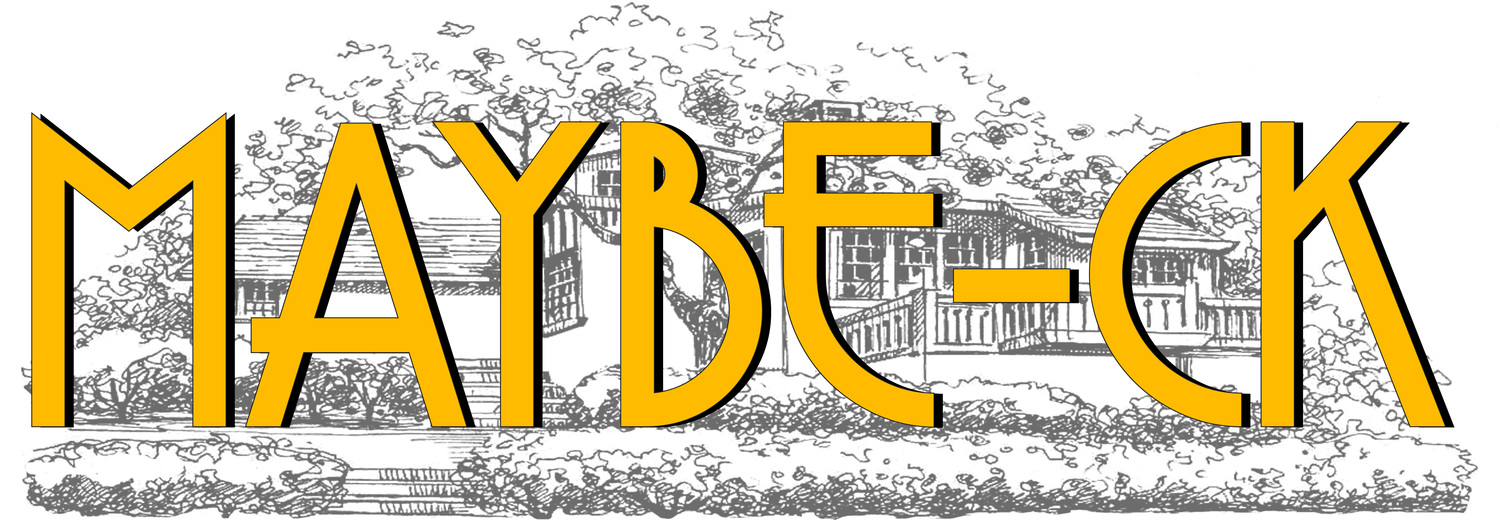Annie Maybeck influenced features?
Annie Maybeck, Bernard's wife and great love, had a big influence on the man and on his work. They were involved with what we might now consider the hippy or environmentalist tone of Berkeley way before the Summer of Love. California was still in its early phases of development around 1900 and Annie and Bernard, along with their artist, poet, and environmental friends were involved in a number of clubs and institutions that were intended to form the blossoming SF Bay Area towards a sort of utopian ideal. They were involved with the Hillside Club which was focused on the Berkeley Hills which intended to implement a set of design principles that would impart a uniform tone of harmony and a certain lifestyle focused on the beauty and outdoor lifestyle possible in a California. The homes were more seen as "shelter in case of rain" rather than asserting themselves above or over nature. The homes were humbly nestled into the hillside and raw and "exposed" natural materials of redwood, cedar, stone and concrete. Paint was seen as unharmonious with the natural surroundings.
(Our home matches very well to the original ideals presented in a Hillside Homes presentation and pamphlet produced by the Hillside Club. )
But the home being part of and second to natural California beauty wasn't the only concern in the development of the Bay Area. Another way to take a backseat to the natural shape and character of the hillside was to create winding roads that didn't require terracing or cutting down trees. Annie was especially interested in the preservation of trees in the area since nearly all of the old growth redwood had been logged by the turn of the century and it seemed development might mean all the big old trees might be cut down in the name of progress unless someone was there to stop them.
And that she did! In one case, Annie famously marched down to city hall to stop an oak tree from being cut down that was in the middle of what was going to become a street. It was dubbed "Annie's Oak." This article sums it up nicely:
http://berkeleyplaques.org/plaque/annie-s-oak/
So what does that have to do with us? Well we have a tunnel in our house through the master bedroom that we believe used to have a tree growing through it!
Tree ramp through the original lone bedroom
I'm not suggesting that Annie Maybeck designed our house, but rather that Bernard was inspired or influenced by her activism to build our house around a tree. The two fed off each other and shared a lot of strong views about the natural order and our place in it. I think this is a very significant detail for any Bay Area home as it exemplifies the the type of thinking and activism going on around that time, led in part by the Maybecks. B. Maybeck had always considered the landscaping to be a part of the design and he often had nature built in or built around the design but never to such a literal extent. One example is the First Church of Christ Scientist that many consider his masterpiece. It was built next to a huge old redwood tree (no longer standin) that Maybeck called "the Steeple."
The inspiration for this idea could have also come from something I read in Maybeck's Landscapes by Dianne Harris. She writes, "No photographs of [naturalist John] Muir's Yosemite Dwelling have come to light, but documents describe a structure constructed entirely of wood, with a stream running through the house, and ferns growing through the floor. The house sat adjacent to the Hutchings Hotel of the 1860s where Muir had once been a guest, the lodging famed for the enormous cedar tree that punctured the hotel's living room floor and extended through the roof."
Another feature of our house we believe was designed by Annie for 2751 Buena Vista in 1932 is our garage top patio. How could your 1927 house have a feature designed in '32 you ask? Our garage was built without permits between '27 and '39. The original permit does not mention the garage, while the '39 additions have it listed as existing. So our Maybeck looking garage was probably done in '33-38. From my research it seems Maybeck tended to use neat little design features for about five to 15 years and at that point they either became part of his repertoire or he shifted his focus elsewhere. One such example would be the exaggerated faux door hinges that were used from around the mid-20s until he retired in 1940. (From what I can tell - not all of his projects have readily available pictures of the front door.)
In Maybeck - The Family View by Jacomena Maybeck she writes, "[Annie] had the carpenters put a floor over a roof and on on top of the garage for decks. 'Don't waste space,' she said."
Our garage with Maybeck features: exaggerated fake hinges that match the front and side doors, a board formed concrete Gothic arch (a key Maybeck touch), and Annie's garage top patio
here are a lot of similarities between our house and the '32 Wallen Maybeck house on 2751 Buena Vista Way. I'm hoping to be able to visit the home soon, owners permitting. If that goes down you'll hear about it here!
